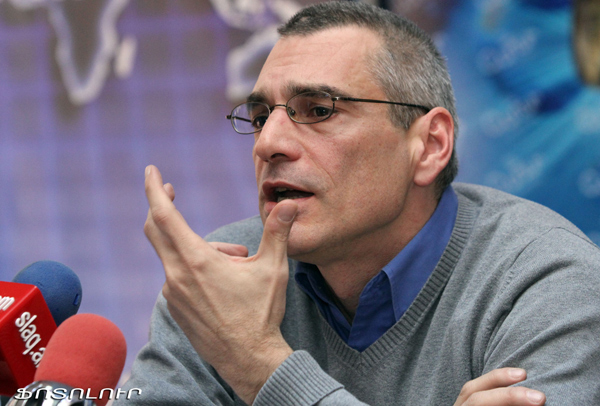Richard Giragosian
Director
Regional Studies Center (RSC)
Yerevan, Armenia
The mediation of the Nagorno Karabakh (Artsakh) conflict has largely been seen as a never ending affair. With little in practical or tangible gains to show for their efforts, the international mediators have routinely hosted meetings between the Armenian and Azerbaijani sides over the years. And while the French, Russian and U.S. OSCE co-chairs have usually followed up such meeting with visits to the region, for the population on the ground, diplomacy has been viewed as being as deadlocked as the conflict itself.
Yet in recent months, there seems to be a flurry of activity, and a sudden acceleration of talks between Yerevan and Baku. This also suggests that the traditional diplomatic breakdown is quickly transforming into a breakthrough. Although this has, of course, sparked renewed concern and fresh debate over the intensified diplomacy, there has been little real analysis of the motives and drivers of this change.
Azerbaijan’s Maximalist Position
For years, Azerbaijan’s diplomatic strategy regarding Karabakh (Artsakh) was easy to decipher and even easier to defeat. Specifically, the Azerbaijani diplomatic strategy was neither diplomatic nor very strategic. Rather, the official Azerbaijani policy has been maximalist, offering little in terms of concession or compromise within the negotiations. This maximalist position may have satisfied a domestic audience within Azerbaijan, which has long served as a priority for the Aliyev government, but such a hard-line and stubborn stance has also tended to frustrate and foil the mediators.
Over time, this maximalist policy has led to decreasing returns for Baku, however, and has further eroded Azerbaijan’s standing within the international community. Such a negative image has only been deepened by the country’s notoriety for entrenched corruption and a flagrant disregard for observing human rights and civil liberties. These factors each contributed to an increasingly negative image for Azerbaijan, which no amount of oil or natural gas could effectively overcome.
A Shift in Diplomatic Strategy
Yet in recent months Azerbaijan’s diplomatic strategy has shifted significantly. Moving away from its maximalist position, the new strategy offered a fresh degree of optimism for the mediators, who were surprised by the reversal and welcomed the signs of a breakthrough for diplomacy.
As evidence of this shift in Azerbaijani strategy, there was a belated agreement to restore the “hot line” of back channel communications between the Azerbaijani and Armenian sides. This was a long standing request, especially important to avoid misunderstanding and to mitigate risk after the April 2016 fighting. But for years, Azerbaijan had refused to restore the link since it was ended unilaterally by Baku. At the same time, Baku also renewed its promises to strengthen the capacity for ceasefire monitoring and to resume other lesser confidence-building measures. Although the latter points have been slow to restart, there are new signs of greater engagement and a determination to fulfill these earlier pledges.
Key Questions
But what is driving this shift in policy? And looking at the timing, why now?
Clearly, the most significant factor contributing to this shift in strategy was the change of government in Armenia last year. For the Azerbaijani leadership, the new Armenian government poses a difficult paradox. On the one hand, the success of Armenian “people power” and the forced resignation of former president Serzh Sarkisian were shocks to Baku. The shock of not only a peaceful handover of power but the sudden departure of Sarkisian scared the Azerbaijani leadership. The so-called “velvet revolution” was not only an inherent threat to the Azerbaijani model of father-son rule, but it also exposed the lack of legitimacy in Azerbaijan.
And after years of dealing with a former Armenian elite, from the Kocharian to the Sarkisian governments, that were not only linked to Karabakh personally and politically, but were also from the same post-Soviet generation, the Azerbaijani leaders are not well prepared or well equipped to deal with the new Armenian reality.
Yet there is another side to this paradox. Most notably, the lack of political or personal ties to Karabakh offers more than a “clean slate,” defined by a fresh start with “no baggage” and “no preconditions.” From a negative perspective, it also reveals the weakness of the Pashinian government in the areas of defense and national security, with little credibility and even less credentials in negotiating over Karabakh. Even the Armenian foreign minister, for example, as good as he is, has no experience in either negotiating with the Azerbaijanis or in managing the Karabakh issue.
In this context, the recent shift in Azerbaijani diplomatic strategy stems from this paradox, and is based on a new tactical test of the new, yet still inexperienced Armenian leadership. And given the sudden acceleration of the peace process, it seems that these tests of Armenian resolve and capacity will likely only intensify. This means, therefore, that the coming months will reveal whether the Armenian side has the maturity and strategic vision necessary to pass these Azerbaijani tests of resolve.
……………………
Richard Giragosian is the director of the Regional Studies Center (RSC), an independent “think tank” in Yerevan, Armenia.

























































